Turkey I: Bulgaria to Georgia (nearly)
 Given just how big Turkey is, we originally thought we’d be sensible and really not try to cover the whole country. Obviously we’d go to Istanbul, we should probably see some of the archaeology on the Aegean coast, and we’d probably have time in between to see a bit of the middle, maybe visit Cappadocia if we were feeling adventurous.
Given just how big Turkey is, we originally thought we’d be sensible and really not try to cover the whole country. Obviously we’d go to Istanbul, we should probably see some of the archaeology on the Aegean coast, and we’d probably have time in between to see a bit of the middle, maybe visit Cappadocia if we were feeling adventurous.
But as soon as we started talking to people in Istanbul about what was out there – from the perspective of food and culture as well as good old tourism – we realised we really had to do a lot more than that. It took longer than we’d planned (sorry Greece, sorry Slovenia) – but it was definitely worth it.
This is the story of the first half – from crossing in over the hills on the Bulgarian border, to getting to our easternmost point in Erzurum (about 150 miles from Iran). Read all about it – there’s mosques! Aubergines! Preserved yoghurt! Getting stopped by police! Getting massaged by blacksmiths! And lots lots more …
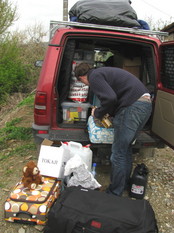 We were feeling quite hung over when we left Bulgaria, having been living it up drinking rakiya with our fine hosts in Kosti. We also suddenly realised that time in Romania and Hungary had left the Land Rover much fuller of alcohol than border regulations strictly allowed. So when it turned out that the Turkish border apparently consisted of one extremely friendly man in a sentry-box, who mainly wanted to know when we were planning to have children, we were quite relieved. (Perhaps we hadn’t needed to hide all that Tokaji in Barnaby’s suitcase.)
We were feeling quite hung over when we left Bulgaria, having been living it up drinking rakiya with our fine hosts in Kosti. We also suddenly realised that time in Romania and Hungary had left the Land Rover much fuller of alcohol than border regulations strictly allowed. So when it turned out that the Turkish border apparently consisted of one extremely friendly man in a sentry-box, who mainly wanted to know when we were planning to have children, we were quite relieved. (Perhaps we hadn’t needed to hide all that Tokaji in Barnaby’s suitcase.)
Starting the car up again and driving round the corner, relief quickly turned into headachey stress as we were faced with a previously invisible large concrete building full of queues. But after more-or-less pleasant chats with the passport people, the car insurance people, the car registration people, the foreign exchange people, the police, and the soldiers with big guns, we were on our way. Did things look different? Not particularly – more mosques, certainly, but we’d seen a fair few in southern Bulgaria too. The villages looked pretty much like villages, and the goats pretty much like goats. And the old men were still sitting outside cafés – although that did look less like firewater and more like tea they were drinking.
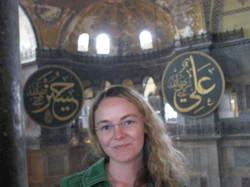 A few hours along the motorway, though, and we were in Istanbul, and starting to get more excited. We’re not the first Europeans to bang on about how exotic and fascinating it is (people like Nerval, Flaubert and Mark Twain were making their livings doing this back in the 1800s), but in our defence it really is pretty exotic and fascinating. This is partly due to the beautiful Ottoman architecture (which we were staying right next to – apparently you can drive a Land Rover right up to the Blue Mosque, as long as you’re naïve enough not to realise exactly what you’re doing).
A few hours along the motorway, though, and we were in Istanbul, and starting to get more excited. We’re not the first Europeans to bang on about how exotic and fascinating it is (people like Nerval, Flaubert and Mark Twain were making their livings doing this back in the 1800s), but in our defence it really is pretty exotic and fascinating. This is partly due to the beautiful Ottoman architecture (which we were staying right next to – apparently you can drive a Land Rover right up to the Blue Mosque, as long as you’re naïve enough not to realise exactly what you’re doing).
 But of course, it was also to do with the food. We got the best possible introduction by meeting the people from the Istanbul Food Workshop: Sharon took us shopping and taught us how to make some classic Ottoman dishes; and Özge took us to meet Musa Dağdeviren at Çiya. This got us started, and there seemed no end to it: balık ekmek under the fishermen-lined Galata bridge; piles of Maraş pepper in the spice market; roasted chestnuts in the streets; stuffed mussels by the ferry piers; desserts of candied fruits (quince, for example); shelves piled with lokum and şerbet; the enormous Topkapı palace kitchens; our first little tulip-shaped glasses of tea. Not to mention all the actual tulips …
But of course, it was also to do with the food. We got the best possible introduction by meeting the people from the Istanbul Food Workshop: Sharon took us shopping and taught us how to make some classic Ottoman dishes; and Özge took us to meet Musa Dağdeviren at Çiya. This got us started, and there seemed no end to it: balık ekmek under the fishermen-lined Galata bridge; piles of Maraş pepper in the spice market; roasted chestnuts in the streets; stuffed mussels by the ferry piers; desserts of candied fruits (quince, for example); shelves piled with lokum and şerbet; the enormous Topkapı palace kitchens; our first little tulip-shaped glasses of tea. Not to mention all the actual tulips …
But while we were here, we kept hearing about the farther-flung parts of the country – especially the southeast. Where were the most beautiful and interesting towns we really shouldn’t miss? The southeast. Where was the baklava even better than this? The southeast. Where was this recipe, this vegetable, this chilli pepper from? We decided we had to go all the way.
 Our first tentative foray beyond Istanbul took us to Sapanca where we met the lovely İrez family; we’ve written about them in detail already, so I won’t say much here other than to remember that it was Zeliha who gave us our first pekmez and our first unforgettable taste of (home-made) sucuk sausage, and Özge who first persuaded us to try carob pods. We’ll be back.
Our first tentative foray beyond Istanbul took us to Sapanca where we met the lovely İrez family; we’ve written about them in detail already, so I won’t say much here other than to remember that it was Zeliha who gave us our first pekmez and our first unforgettable taste of (home-made) sucuk sausage, and Özge who first persuaded us to try carob pods. We’ll be back.
Next we spent a night near Mudurnu in a lovely little cabin in the hills surrounded by excited frogs, that we should have enjoyed hugely, but somehow didn’t quite. The countryside didn’t help: it wasn’t quite escaping the Istanbul smog, and seemed to be suffering from pretty bad erosion problems. But we suddenly realised that we had a bigger problem: we were in Turkey, and we didn’t speak any Turkish. For the first time we realized that Istanbul (and Özge) weren’t representative – not everyone in Turkey speaks flawless English. With several weeks of waving and pointing and (more crucially) having to guess at ingredients and recipes staring us in the face, we got out our dictionary and started learning. And we’re very glad that we did – a lot of the adventures that came afterwards wouldn’t have happened otherwise.
 For a start, Anna wouldn’t have ended up two days later talking (well, maybe mostly smiling) her way into a simit bakery. We’d got to Safranbolu the night before (thanks to Tom’s recommendation) and one of the first places we noticed in the morning was a tiny shop selling simit, the ubiquitous bagelly sesame-seedy rings. We stuck our heads in and got chatting to the man who worked the
For a start, Anna wouldn’t have ended up two days later talking (well, maybe mostly smiling) her way into a simit bakery. We’d got to Safranbolu the night before (thanks to Tom’s recommendation) and one of the first places we noticed in the morning was a tiny shop selling simit, the ubiquitous bagelly sesame-seedy rings. We stuck our heads in and got chatting to the man who worked the
huge wood-fired oven; pretty soon the guy who made the dough rings and the one who boiled them in the big tub of water had joined in; and within minutes they were giving Anna a hands-on lesson in simit-rolling. (We’ve got video evidence of this – promise we’ll put it up here soon).
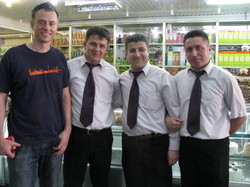 But it turned out that this kind of openness and generosity with time is the rule here, not the exception. Later the same day, we went in search of the local Safrantat lokum (Turkish delight) factory; our taxi driver wasn’t sure where it was, but he took us to a shop and talked someone into coming to help us; and he then immediately took time out to take us to the factory, walk us round, introduce us to all the main people, and explain the whole lokum-making process in detail (thank you Engin). Then took us to a couple of shops to sample all their best bits and drink a lot of tea.
But it turned out that this kind of openness and generosity with time is the rule here, not the exception. Later the same day, we went in search of the local Safrantat lokum (Turkish delight) factory; our taxi driver wasn’t sure where it was, but he took us to a shop and talked someone into coming to help us; and he then immediately took time out to take us to the factory, walk us round, introduce us to all the main people, and explain the whole lokum-making process in detail (thank you Engin). Then took us to a couple of shops to sample all their best bits and drink a lot of tea.
The kindness continued that evening. We went to the Havuzlu Köşk restaurant in another part of town; as well as serving us delicious food in a lovely Ottoman-style room complete with peaceful water features, they put up with our clumsy Turkish questions, explained all their ingredients (writing everything down to make sure we got it right!) and then sent us off home in a pre-paid taxi! To round it off, after getting back to our lovely Ottoman mansion, our host Nihan stayed up with us after midnight explaining how she makes her own special pasta and tarhana …
 That wasn’t all Safranbolu had to offer: we had midnight games of football with the local children; saw how silversmiths engrave their (soon to be our) tea saucers and tin their (yes, soon to be ours too) sucuk pans; learnt all about how Ottoman houses are divided in two; and found out that a conversation with a blacksmith can soon turn into a lesson in numismatism and a (semi-)professional massage (thank you Kazım). But we had to leave soon enough to push on further east.
That wasn’t all Safranbolu had to offer: we had midnight games of football with the local children; saw how silversmiths engrave their (soon to be our) tea saucers and tin their (yes, soon to be ours too) sucuk pans; learnt all about how Ottoman houses are divided in two; and found out that a conversation with a blacksmith can soon turn into a lesson in numismatism and a (semi-)professional massage (thank you Kazım). But we had to leave soon enough to push on further east.
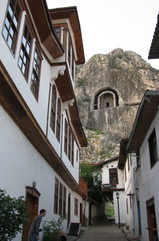 Next came Amasya, dramatically situated in a gorge, covered in ancient Pontic tombs looking down from the rocky sides, and full of lovely old Ottoman houses (including the İlk Pansiyon we stayed in). Also full of dingy smoke-filled restaurants serving soggy kebabs, but you can’t have everything. And then we hit the Black Sea coast, planning to stop at the first picturesque little seaside village we came across. After many hours of dreary built-up medium-sized towns we thought we should admit defeat, and stopped in Giresun, buoyed by the fact that we’d read it was the hazelnut capital of Turkey.
Next came Amasya, dramatically situated in a gorge, covered in ancient Pontic tombs looking down from the rocky sides, and full of lovely old Ottoman houses (including the İlk Pansiyon we stayed in). Also full of dingy smoke-filled restaurants serving soggy kebabs, but you can’t have everything. And then we hit the Black Sea coast, planning to stop at the first picturesque little seaside village we came across. After many hours of dreary built-up medium-sized towns we thought we should admit defeat, and stopped in Giresun, buoyed by the fact that we’d read it was the hazelnut capital of Turkey.
 Hazelnuts it certainly has (even going so far as to erect statues to them), and hamsi too – the small fish which the Black Sea coast is famous for. But this apparently doesn’t guarantee the beauty of a town, nor its ability to provide restaurants which serve more than döner kebab and köfte. (Although I should add that our rather ugly square concrete block hotel did turn out to be staffed by very friendly helpful people, who gave us free upgrades and tips on avoiding PKK terrorist blackspots on our way south – more of that later.) Eventually we did track a non-fast-food restaurant down, on the top floor of another similarly ugly hotel, and asked for their finest local specialities. These came quickly – a plate of hamsi (arranged in a circle), and a plate of hazelnuts (arranged in a pile). Hard to argue, I suppose.
Hazelnuts it certainly has (even going so far as to erect statues to them), and hamsi too – the small fish which the Black Sea coast is famous for. But this apparently doesn’t guarantee the beauty of a town, nor its ability to provide restaurants which serve more than döner kebab and köfte. (Although I should add that our rather ugly square concrete block hotel did turn out to be staffed by very friendly helpful people, who gave us free upgrades and tips on avoiding PKK terrorist blackspots on our way south – more of that later.) Eventually we did track a non-fast-food restaurant down, on the top floor of another similarly ugly hotel, and asked for their finest local specialities. These came quickly – a plate of hamsi (arranged in a circle), and a plate of hazelnuts (arranged in a pile). Hard to argue, I suppose.
It was perhaps in an effort to make it out of Giresun as quickly as possible that we found ourselves going rather too fast through a police radar trap on the outskirts of Trabzon. This was not to be our last meeting with Turkish highway police, but set the tone well – initial concern, stern looks and demands for documents rapidly giving way to lively discussion of the recent Chelsea-Fenerbahçe game, establishment of support for Tottenham and Galatasaray instead, and smiles all round.  Feeling relieved and slightly smug, we stopped in Trabzon for some of the famed and slightly mysterious Laz böreği – which turned out to be a custard tart with a lot of black pepper in. Little did we know that it would turn up again in Greece …
Feeling relieved and slightly smug, we stopped in Trabzon for some of the famed and slightly mysterious Laz böreği – which turned out to be a custard tart with a lot of black pepper in. Little did we know that it would turn up again in Greece …
When you get to Trabzon, the scenery shifts; after being used to miles upon miles of nut trees and rather dull flat coast, you suddenly look up and see tea bushes and the Kaçkar mountains – covered in snow, towering in the distance and telling us that we were getting near Georgia and the Caucasus. These mountains were where we were going – to Çamlıhemşin, famed for its trekking and its tea.
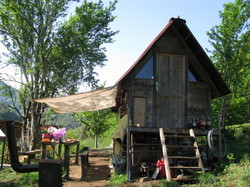 We’d come here because we’d heard about a new eco-lodge that had been started up in the hills. We weren’t entirely sure we knew where it was, but trusted our directions, following misty mountain roads up through the tea plantations, until they ended in a tiny dirt track of the sort we’d recently learnt not to try to drive down.&nb
We’d come here because we’d heard about a new eco-lodge that had been started up in the hills. We weren’t entirely sure we knew where it was, but trusted our directions, following misty mountain roads up through the tea plantations, until they ended in a tiny dirt track of the sort we’d recently learnt not to try to drive down.&nb
sp; So we got out and started walking through the undergrowth (trying to look eco-savvy with our walking boots and hiding our designer toiletries bag). Eventually we came out in a pretty little clearing full of tea bushes, kiwifruit, currants, four sweet little wooden cabins, a nearly-finished bread oven and Mehmet and Kadar’s children running around.
 They’ve built (or rather, are still building) a lovely place, and we loved spending time there. Mehmet has a thousand stories to tell, ranging from Xenophon’s exploits with mad honey in the village just up the hill, to how the Hemşin people came from Armenia to end up running the best bread bakeries all round Turkey. We felt like part of the family, staying up to make cheese fondue (a Hemşin speciality) by torchlight, meeting the relatives, and generally being sad to leave only a couple of days later.
They’ve built (or rather, are still building) a lovely place, and we loved spending time there. Mehmet has a thousand stories to tell, ranging from Xenophon’s exploits with mad honey in the village just up the hill, to how the Hemşin people came from Armenia to end up running the best bread bakeries all round Turkey. We felt like part of the family, staying up to make cheese fondue (a Hemşin speciality) by torchlight, meeting the relatives, and generally being sad to leave only a couple of days later.
Leaving Çamlıhemşin meant leaving the north-east and heading south. We took a lot of advice on which way to go, as we’d be driving through areas that until a few years ago were considered dangerous PKK territory; and although we knew the situation had actually been very peaceful for some years, the last few months’ news of Turkish incursions into Kurdish Iraq suggested that this might no longer be the case. But everyone was agreed that there was nothing to worry about on the first half of the southward leg – just head over the hills to Erzurum. No problem.
 Unless, of course, the “hills” are a range of bleak rocky snow-covered mountains, with the only road over them being a single-file gap carved through several feet of snow, cars driving directly at you from the other direction, and no parapet separating you from hundreds of feet of sheer rock-face drop on the passenger-seat side. Or as it is known in our car, Anna’s side. Funnily enough, Anna has never been particularly keen on steep rocky slopes. Although I think she must be getting better: as we swerved towards the drop to avoid one particularly big truck she even asked to stop and get out.
Unless, of course, the “hills” are a range of bleak rocky snow-covered mountains, with the only road over them being a single-file gap carved through several feet of snow, cars driving directly at you from the other direction, and no parapet separating you from hundreds of feet of sheer rock-face drop on the passenger-seat side. Or as it is known in our car, Anna’s side. Funnily enough, Anna has never been particularly keen on steep rocky slopes. Although I think she must be getting better: as we swerved towards the drop to avoid one particularly big truck she even asked to stop and get out.
 Anyway, we made it in the end, and Erzurum turned out to be a lot more than just a stop on the way south. It was our first taste of how different the far east of Turkey feels (although Trabzon and Rize, which we’d been through on the Black Sea coast, are nearly as far east, they feel much more western – maybe something to do with their old Greek heritage?). This was partly to do with the more Islamic feel, partly to do with the different architecture (forget Ottoman mosques, here it’s all about the Seljuks and the Mongols – seriously old, beautiful geometric designs, and not like anything I’d expected).
Anyway, we made it in the end, and Erzurum turned out to be a lot more than just a stop on the way south. It was our first taste of how different the far east of Turkey feels (although Trabzon and Rize, which we’d been through on the Black Sea coast, are nearly as far east, they feel much more western – maybe something to do with their old Greek heritage?). This was partly to do with the more Islamic feel, partly to do with the different architecture (forget Ottoman mosques, here it’s all about the Seljuks and the Mongols – seriously old, beautiful geometric designs, and not like anything I’d expected).
 But it was also to do with how we were seen. This part of the country doesn’t see many western tourists, and we were gradually becoming more of a novelty – children would give up their games of football just for the chance of talking to us, trying to tell us what their name was, how old they were and whether they liked strawberries. Then add to this the ubiquitous Turkish hospitality, and you can see how we met a lot of people in one evening; for example, an attempt to walk past a calligraphy exhibition ended in meeting the organiser, being introduced to the calligraphers, being taken in free of charge and shown around (beautiful).
But it was also to do with how we were seen. This part of the country doesn’t see many western tourists, and we were gradually becoming more of a novelty – children would give up their games of football just for the chance of talking to us, trying to tell us what their name was, how old they were and whether they liked strawberries. Then add to this the ubiquitous Turkish hospitality, and you can see how we met a lot of people in one evening; for example, an attempt to walk past a calligraphy exhibition ended in meeting the organiser, being introduced to the calligraphers, being taken in free of charge and shown around (beautiful).
 We also met a lot more restaurateurs in Erzurum than we expected to in one day. You can’t really walk past a place with sheep’s heads on display outside without at least saying hello. And you can’t pass up a chance to sample çağ kebab (it’s not made anywhere else). Nor a chance to drink foamy ayran in a Hemşin teahouse. And we had to stop somewhere else to try lahmacun – we’d never had it before. So as we went to bed, preparing for the next day’s drive into the southeast proper, we were well fed, excited and had learnt as much in a day as we’d expected to learn in a week. A thoroughly representative introduction, as it turned out …
We also met a lot more restaurateurs in Erzurum than we expected to in one day. You can’t really walk past a place with sheep’s heads on display outside without at least saying hello. And you can’t pass up a chance to sample çağ kebab (it’s not made anywhere else). Nor a chance to drink foamy ayran in a Hemşin teahouse. And we had to stop somewhere else to try lahmacun – we’d never had it before. So as we went to bed, preparing for the next day’s drive into the southeast proper, we were well fed, excited and had learnt as much in a day as we’d expected to learn in a week. A thoroughly representative introduction, as it turned out …
Read about the second half of our culinary journey through Turkey here.
You can see some of our photos from this part of Turkey here, and (for Erzurum) here.

 Follow
Follow
Comments are closed